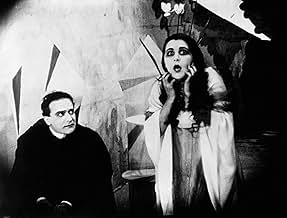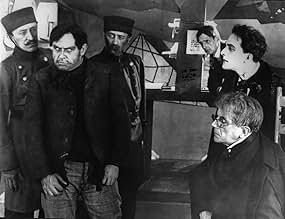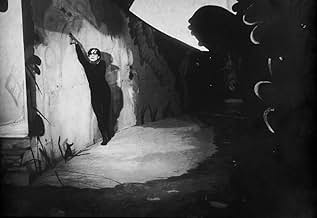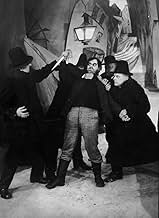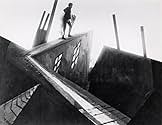IMDb RATING
8.0/10
72K
YOUR RATING
Hypnotist Dr. Caligari uses a somnambulist, Cesare, to commit murders.Hypnotist Dr. Caligari uses a somnambulist, Cesare, to commit murders.Hypnotist Dr. Caligari uses a somnambulist, Cesare, to commit murders.
- Awards
- 2 wins & 1 nomination
Friedrich Feher
- Franzis
- (as Friedrich Fehér)
Hans Heinrich von Twardowski
- Alan
- (as Hans Heinz v. Twardowski)
Rudolf Lettinger
- Dr. Olsen
- (as Rudolph Lettinger)
Rudolf Klein-Rogge
- Ein Verbrecher
- (uncredited)
- …
Hans Lanser-Ludolff
- Ein Alter Mann
- (uncredited)
- …
Henri Peters-Arnolds
- Ein Junger Arzt
- (uncredited)
- …
Ludwig Rex
- Ein Mörder
- (uncredited)
- …
Elsa Wagner
- Die Wirtin
- (uncredited)
- …
- Director
- Writers
- All cast & crew
- Production, box office & more at IMDbPro
Storyline
Did you know
- TriviaWriter Hans Janowitz claims to have gotten the idea for the film when he was at a carnival one day. He saw a strange man lurking in the shadows. The next day he heard that a girl was brutally murdered there. He went to the funeral and saw the same man lurking around. He had no proof that the strange man was the murderer, but he fleshed the whole idea out into his film.
- GoofsIn the wide shot, the sign at the asylum reads "Insane Asylum," in English. In the close-up, the sign is written in German (Kino Blu-ray Disc version, may not be present in all editions of the film).
- Alternate versionsUSA laserdisc reissue restores the original hand-drawn title cards that have been missing from every known print of the film since 1923. When first released on video in the United States, film was in black-and-white, and played back many scenes at double speed and featured different music. Although no scenes were cut out, the running time was reduced to only 51 minutes. The restored version restores the colour-tinting, restores the original title cards, and plays the film back at regular speed, returning the film to its original 69-minute running time.
- ConnectionsEdited into People Who Die Mysteriously in Their Sleep (2004)
Featured review
Like so many of the films from the silent era, The Cabinet of Dr. Caligari gets overlooked (if you can even find it!) for big budget duds, and runny romantic comedies. Directors of the period like Griffith, Lang, Eisenstien, and Caligari's Wiene, are never given the credit they deserve. And if credit is given, it is in small cultish circles in various pockets around the world.
The set design here is amazing, not a single right angle can be found in any one of the sets. This may not only apply to the disjointed and distorted characters in the film, but also the state of Germany at the time. After all, the film was made in the dark ages in Germany between WWI and WWII. This point is validated by Siegfried Kracauer, with his notion of how the main character of Dr. Caligari can be easily interpreted to Hitler, and vice versa. Both controlled subjects with a form of "brainwashing", both were upset with current forms of society and government, and both were masters of deception. In a period where Germans were looking for direction, and let's face it, authority as well, Dr. Caligari embodied it fully.
In the area of the players, all the names in the film turn out a literally "speechless" performance. Dagover, Krauß, and especially Veidt as Cesare (pronounced Chez-a-ray) are excellent in the use of gestures and motion to get their point across without using words. The camera, stationary as in most early features, uses the mise-en-scene effectively, letting us identify with characters such as Francis and Jane, and disjointing us from Caligari, and the Criminal.
The use of lines and stripes, not only in the sets but in small places like in the good doctor's hair and on his gloves, adds to the telling of the character. Colour tints of the B&W film also play a special part in bringing the whole film together. An amazing sequence where Caligari reveals his true madness, pits Caligari stumbling through the unequal streets of Germany while being haunted by textual ramblings written in the air. A marvelous achievement for it's time. And it adds so much.
The Cabinet Of Dr. Caligari has changed the way I look at horror films, and even films in general. I urge anyone reading this to pick up this film. The DVD offering is utterly fantastic with the restored print, an audio essay of the film, and production notes. Bypass the overblown "motion picture events of the year", and pick up Caligari, quite possible the greatest motion picture event in the history of motion pictures.
The set design here is amazing, not a single right angle can be found in any one of the sets. This may not only apply to the disjointed and distorted characters in the film, but also the state of Germany at the time. After all, the film was made in the dark ages in Germany between WWI and WWII. This point is validated by Siegfried Kracauer, with his notion of how the main character of Dr. Caligari can be easily interpreted to Hitler, and vice versa. Both controlled subjects with a form of "brainwashing", both were upset with current forms of society and government, and both were masters of deception. In a period where Germans were looking for direction, and let's face it, authority as well, Dr. Caligari embodied it fully.
In the area of the players, all the names in the film turn out a literally "speechless" performance. Dagover, Krauß, and especially Veidt as Cesare (pronounced Chez-a-ray) are excellent in the use of gestures and motion to get their point across without using words. The camera, stationary as in most early features, uses the mise-en-scene effectively, letting us identify with characters such as Francis and Jane, and disjointing us from Caligari, and the Criminal.
The use of lines and stripes, not only in the sets but in small places like in the good doctor's hair and on his gloves, adds to the telling of the character. Colour tints of the B&W film also play a special part in bringing the whole film together. An amazing sequence where Caligari reveals his true madness, pits Caligari stumbling through the unequal streets of Germany while being haunted by textual ramblings written in the air. A marvelous achievement for it's time. And it adds so much.
The Cabinet Of Dr. Caligari has changed the way I look at horror films, and even films in general. I urge anyone reading this to pick up this film. The DVD offering is utterly fantastic with the restored print, an audio essay of the film, and production notes. Bypass the overblown "motion picture events of the year", and pick up Caligari, quite possible the greatest motion picture event in the history of motion pictures.
Details
- Release date
- Country of origin
- Language
- Also known as
- Кабінет доктора Каліґарі
- Filming locations
- Production company
- See more company credits at IMDbPro
Box office
- Budget
- $18,000 (estimated)
- Gross US & Canada
- $8,811
- Gross worldwide
- $9,297
- Runtime1 hour 7 minutes
- Sound mix
- Aspect ratio
- 1.37 : 1
Contribute to this page
Suggest an edit or add missing content

Top Gap
By what name was The Cabinet of Dr. Caligari (1920) officially released in India in English?
Answer

